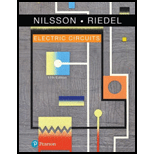
Concept explainers
(a)
Find the values of average power
(a)
Answer to Problem 1P
The values of
Explanation of Solution
Given data:
From the given expressions, the required parameters are written as follows:
Formula used:
Write the expression for average power as follows:
Here,
Write the expression for reactive power as follows:
Calculation:
Substitute 100 V for ,
As the average power is obtained with positive sign, the average is absorbed from the terminals of the box in the given circuit.
Substitute 100 V for ,
As the reactive power is obtained with positive sign, the magnetizing VARs are absorbed from the terminals of the box in the given circuit.
Conclusion:
Thus, the values of
(b)
Find the values of average power
(b)
Answer to Problem 1P
The values of
Explanation of Solution
Given data:
From the given expressions, the required parameters are written as follows:
Calculation:
Substitute 40 V for ,
As the average power is obtained with positive sign, the average is absorbed from the terminals of the box in the given circuit.
Substitute 40 V for ,
As the reactive power is obtained with negative sign, the magnetizing VARs are delivered to the terminals of the box in the given circuit.
Conclusion:
Thus, the values of
(c)
Find the values of average power
(c)
Answer to Problem 1P
The values of
Explanation of Solution
Given data:
From the given expressions, the required parameters are written as follows:
Calculation:
Rewrite the given expression of current as follows:
Therefore, the value of
Substitute 400 V for ,
As the average power is obtained with negative sign, the average is delivered to the terminals of the box in the given circuit.
Substitute 400 V for ,
As the reactive power is obtained with negative sign, the magnetizing VARs are delivered to the terminals of the box in the given circuit.
Conclusion:
Thus, the values of
(d)
Find the values of average power
(d)
Answer to Problem 1P
The values of
Explanation of Solution
Given data:
From the given expressions, the required parameters are written as follows:
Calculation:
Rewrite the given expression of voltage as follows:
Therefore, the value of
Substitute 200 V for ,
As the average power is obtained with negative sign, the average is delivered to the terminals of the box in the given circuit.
Substitute 200 V for ,
As the reactive power is obtained with positive sign, the magnetizing VARs are absorbed from the terminals of the box in the given circuit.
Conclusion:
Thus, the values of
Want to see more full solutions like this?
Chapter 10 Solutions
Electric Circuits. (11th Edition)
- 3- For the network below determine the value of R for maximum power to R (use Thevenin equivalent) and determine the value of maximum power R₁ 1.2Ω E + 12 V I D 10 A R₂60 6Ω Rarrow_forwardPlease solve this problem in detail to understandarrow_forwardQ3: (40 Marks) Single phase full bridge voltage source inverter has an RLC load with R-1002, L-31.5mH and C=112µF. The inverter frequency is 60Hz and de input voltage is 220V. (a) Express the instantaneous load current in Fourier series to third harmonic. (b) Calculate the RMS load current at the fundamental frequency (n=1). (c) Calculate the load power due to fundamental component (n=1).arrow_forward
- 12.3 Express each of the waveforms in Fig. P12.3 (on page 667) in terms of step functions and then determine its Laplace transform. [Recall that the ramp function is related to the step function by r(t − T) = (t − T) u(t − T).] Assume that all waveforms are zero for t<0. - - -arrow_forwardEvaluate each of the following integraarrow_forwardWith the aid of suitable diagrams, describe the benefits that antenna arrays have over singleelement antennas, with their applicationsarrow_forward
- Explain what is meant by an electric dipole antenna, sketch its radiation pattern, state itsdirectivity and describe its main applicationsarrow_forwardEstimate the length required for a half-waveelectric dipole antenna for transmitting/receiving EM waves at 800 MHz (this is in the UHFbandwidth of 470 to 860 MHz, used for UK TV transmissions).arrow_forwardIf the voltage waveform in Fig. 6.68 is applied to a 50-mH inductor, find the inductor current i(1). Assume i(0) = 0.arrow_forward
- Q3/A 8-pole, 3-phase, 50 Hz induction motor, running at 725 r.p.m, rotor is star connected its resistance and reactance 0.25 and 1.5 ohm per phase, the emf between slip rings is 100, find the rotor current per phase, power factor, synchronous speed, slip and rotor frequencyarrow_forward440 v, 4-pole, 3-phase, 50 Hz, star stator connected induction motor, full load speed 1425 r.p.m, rotor impedance 0.5+4.55ohm and rotor/stator ratio 0.8 calculate 1) starting torque, (2) rotor current (3) the value of external resistance to add to give maximum starting torque (4) power factor at maximum torque.arrow_forwardI would like to know the gear ratio and the tractive effort that a trolley must achieve with the following motor specifications: Voltage: 600 voltsSpeed: 1750 to 2300 RPMCurrent: 84 AmpsRated Power: 50-55 HP What percentage should be considered for gear efficiency, and what safe margin should be applied in these calculations? The constraints for the truck trolley are as follows:Maximum Speed: 50 MPHWeight of the Car Body: 46,000 lbs (the trolley weighs approximately 44,000 lbs)Diameter wheels: 86 inchesAdditionally, I would like to know how to plot a graph of tractive effort (in grams) versus speed (in MPH).arrow_forward
 Introductory Circuit Analysis (13th Edition)Electrical EngineeringISBN:9780133923605Author:Robert L. BoylestadPublisher:PEARSON
Introductory Circuit Analysis (13th Edition)Electrical EngineeringISBN:9780133923605Author:Robert L. BoylestadPublisher:PEARSON Delmar's Standard Textbook Of ElectricityElectrical EngineeringISBN:9781337900348Author:Stephen L. HermanPublisher:Cengage Learning
Delmar's Standard Textbook Of ElectricityElectrical EngineeringISBN:9781337900348Author:Stephen L. HermanPublisher:Cengage Learning Programmable Logic ControllersElectrical EngineeringISBN:9780073373843Author:Frank D. PetruzellaPublisher:McGraw-Hill Education
Programmable Logic ControllersElectrical EngineeringISBN:9780073373843Author:Frank D. PetruzellaPublisher:McGraw-Hill Education Fundamentals of Electric CircuitsElectrical EngineeringISBN:9780078028229Author:Charles K Alexander, Matthew SadikuPublisher:McGraw-Hill Education
Fundamentals of Electric CircuitsElectrical EngineeringISBN:9780078028229Author:Charles K Alexander, Matthew SadikuPublisher:McGraw-Hill Education Electric Circuits. (11th Edition)Electrical EngineeringISBN:9780134746968Author:James W. Nilsson, Susan RiedelPublisher:PEARSON
Electric Circuits. (11th Edition)Electrical EngineeringISBN:9780134746968Author:James W. Nilsson, Susan RiedelPublisher:PEARSON Engineering ElectromagneticsElectrical EngineeringISBN:9780078028151Author:Hayt, William H. (william Hart), Jr, BUCK, John A.Publisher:Mcgraw-hill Education,
Engineering ElectromagneticsElectrical EngineeringISBN:9780078028151Author:Hayt, William H. (william Hart), Jr, BUCK, John A.Publisher:Mcgraw-hill Education,





